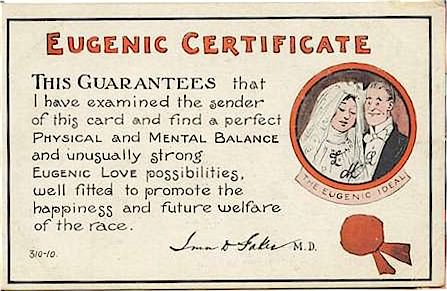When you think of modern abuses of science, what comes to mind? I think of socialism, murderous nuclear weapons, Keynesian economic planning, and the current “climate change” frenzy to shut down industrial civilization.
What doesn’t usually come to mind is the American eugenics movement — early Progressive Era through the 1950s — that served as a model for the Nazi party’s exterminationist agenda, as thoroughly documented in War Against the Weak: Eugenics and America’s Campaign to Create a Master Race (2003) by Edwin Black.
The more I read about this, the more I realize that it’s probably not possible fully to grasp the rise of leviathan in the 20th century without coming to terms with the eugenics movement, which produced our own home-grown holocaust.
I just lectured on this topic, to a group gathered by the Foundation for Economic Education, a very diverse group of students from all nations and ethnic, racial, and cultural backgrounds. I found myself uncomfortable raising this topic at all, all too aware that this history is a reminder of how central a role that a ruling caste system has been, even in our recent history, and just how fragile is the idea of human freedom so long as one people imagines itself as possessing more rights than others and has access to a piece of machinery, the state, to make it so.
As an example of its continued legacy, consider the issue of gay marriage that is such a source of controversy. Why is the state even involved so deeply in marriage in the first place? The marriage license in the United States was used and entrenched for eugenics reasons. Governments and the elite intellectuals who influenced them did not want undesirables reproducing. Even today in many states you need to get a clean bill of health in order to marry and presumably gain procreation rights. This is a legacy from 100 years ago when it was a matter of gaining a clean bill of racial health from public authorities charged with managing our demographic destiny.
This is only one small aspect of the continued legacy of eugenics as a form of state planning. Yet it is only one of the many legacies of these policies of selective breeding and forced sterilization. We now have massive access to archives, and a solid shelf of literature, that tell the full and ugly truth about what was going on.
I have the strong impression that in American education and popular culture, people don’t hear much about this at all. It is the great non-event to most school kids. Everyone acts as if this stuff was unique to the Nazis, and surely we’ve already gotten rid of those weird people.
Here’s the rough outline. In the latter part of the 19th century, incomes rose and lifetimes expanded as never before in history, and this pertained to all races and classes. Infant mortality collapsed. All of this was due to a massive expansion of markets, technology, and trade, and it truly changed the world. It meant a dramatically expanding population from all groups. The great unwashed masses were living long and reproducing as never before.
You might think this would be a cause for celebration, but no. It worried the white ruling class in most European countries and the U.S. As John Carey documented in Intellectuals and the Masses (1992), all the founders of modern literary culture — from H.G. Wells to T.S. Elliot — loathed the new prosperity and variously spoke out on behalf of extermination and racial cleansing to put an end to newly emerged demographic trends. As Wells summed up, “The extravagant swarm of new births was the essential disaster of the nineteenth century.”
Further, a scientific movement arose in the wake of Darwinian theory that fretted mightily that if the dark skinned, diseased, drunken, immoral, insane, and stupid people continued to propagate at the current rates, they would overtake the elites and wipe out civilization as we knew it.
The movement began with bad science, the presumption that wiping people out who had a congenital disease would kill that disease off within the gene pool. But what is and isn’t a disease, and the cause and effect thereof, became very slippery. The belief in a recessive gene for “the feeble-minded, drunkards, paupers, sex offenders, and criminals” was next, and the underlying scientific preference for whites was a given.
All of this resulted from a demographic panic.
The proposed solution was known as eugenics, the hope to plan the gene pool just as socialism planned the economy. The ambition was to wipe out undesirable recessive genes in one generation.
The movement was funded by the foundations established from Gilded Age fortunes: Rockefeller, Carnegie, and Harriman. The academic journals in every field — politics, economics, anthropology, biology, sociology — were packed with proposals from immigration policy to sterilization to outright extermination. The schools taught the idea: a documented 376 university courses advocated it, and tens of thousands of students took the courses.
All fashionable opinion endorsed it. Historians of this period commented on just how remarkable it is that there were few if any dissenters at all, anywhere in the academic journals. It was the prevailing ideology of the time — however taboo this subject might be today.
I recall variously reading about the subject in the journals in digging through the archives, and the results are deeply embarrassing. They speak of superior and inferior blood, the preservation of the white race, the need to block inferiors from reproducing. I always figured that these were anomalous opinions, appearing here and there among a handful of malicious types. Not so. The whole of academia was shot through with this stuff.
Eugenics guru Charles B. Davenport — Harvard and Chicago and the best the profession had to offer — established the American Breeder’s Institute to become the most influential think tank for policy. They worked the political world hard. By 1935, more than half the states had compulsory sterilization laws. California was the worst: it forcibly sterilized 10,000 “mental defectives.” In the decades before World War II, states compulsorily sterilized some 100,000 people.
Eugenics had influence in other areas of American policy, such as racial segregation. Obviously you can’t have the races socializing and partying together if the goal is to gradually exterminate one and boost the population of the other. This is a driving force behind such policies as regulations on dance clubs, for example, and also the minimum wage, which was first conceived of as a policy to impoverish the lower classes to disincentivize their reproduction.
It was the key to immigration reform in the 1920s, which shut down the flow of immigrants from non-Anglo Saxon lands. The ostensible reason here was essentially nativist and nationalist but there was also the “scientific” rationale: the quality of the national population had to be improved.
Eugenic policies were affirmed by the Supreme Court in Buck vs. Bell (1927) (the case centered on a woman who was involuntarily sterilized in Virginia) with the beloved jurist Oliver Wendell Holmes writing for the majority:
“We have seen more than once that the public welfare may call upon the best citizens for their lives. It would be strange if it could not call upon those who already sap the strength of the State for these lesser sacrifices, often not felt to be such by those concerned, in order to prevent our being swamped with incompetence. It is better for all the world, if instead of waiting to execute degenerate offspring for crime, or to let them starve for their imbecility, society can prevent those who are manifestly unfit from continuing their kind. The principle that sustains compulsory vaccination is broad enough to cover cutting the Fallopian tubes.”
This decision effectively made eugenics a national policy, permissioning governments at all levels to do what was necessary to clean up the national stock. Reading through this material, you almost have to wonder why government didn’t do more than they did, given the prevailing opinion of the academic elites. That policies weren’t more aggressive can only be due to two factors: the people did not share this view, and, further, people are not so easily controlled. As it was, forced sterilization could only be enacted once a person (actually, woman is more accurate since they were 80% of the victims) found herself at the hospital or embroiled in some social work case.
How easy it is to sweep all of this grim history under the carpet, blaming the Nazis and Hitler and imagining that “we” had nothing to do with it. In fact, it is all part of the deep history of the 20th century, a horrid stain on elite academia, and also a warning about the unity of science and the state. Science makes errors, sometimes ghastly ones. When error is enshrined in law, the consequences can be unthinkable. Erect a wall of separation between science and the coercive powers of government and you can at least minimize the damage.














Wow! That quote by Holmes is chilling.
Is eugenics still being practiced today?
The Welfare State
The rise of socialism and the modern eugenics movement coincided to a large degree, not only in timing, but in the identity of the proponents.
Socialism is again on the rise, and, though mostly hidden, eugenics is again following closely behind. It can be clearly seen in the policies of insurance companies and in government health care regulations and guidelines. It is already prohibited for certain people, particularly the elderly, to receive various treatments, regardless of their ability to pay.
Jeffrey Tucker’s mention of marriage and how it relates to eugenics is right on the mark. This is the reason I oppose all legislation regarding marriage, even though that sometimes places me at odds with supporters of same sex marriage. The only legislation I will support is that in which the government is completely removed from marriage.
I agree Mike. I have tried to explain to same sex marriage advocates that they should rather advocate against state licensing of relationships but I rarely can evince a thoughtful response. It’s all about fairness under the state.
Thanks for bringing this to light, Jeffrey. It drives me crazy how people remember all the horrible things Germany did during that era and completely forget about how everyone else was doing it at the time. It allows us to demonize one group and pretend that we’re better than that. The truth is the whole world bought into the idea of eugenics and if we forget that, if we separate from that, if we don’t allow ourselves to see the evil inside of us, it makes it so much easier to repeat the same mistakes over and over again.
Great article. When I think of modern abuses of science, the first thing that usually comes to mind is “scientific racism”. This has a connection to eugenics, but since confirmation bias is one of my favorite areas of interest, when science and its supposed rationality is used to justify complete control over other people, I find this to be an important lesson in the importance of skepticism. Including, or perhaps especially, in science.
Science is an extremely valuable tool: its intent is to yield nothing less than the truth. If we cannot trust science, then what can we trust? This is why I feel we are wise to challenge scientific “certainty” and never forget that all theories in science (and all theories of any kind), are provisional. If more skepticism was brought to eugenics and “scientific racism” then the violence and horror involved in abuse would have been much more difficult (perhaps impossible) to justify and to continue on such massive scales.
Incredible article – thank you Jeffrey. And thanks also to those above for the insights and comments. LM opens yet another dark corner of my mind!
Thanks for the article, Jeffrey. Once again the US education system fails us all. From their strong support of this blatantly evil policy to their complete neglect of covering it in modern curricula. I would have never known about the eugenics movement if I hadn’t read about it myself in independent study in high school. Not once in my school career, from kindergarten to doctorate, was it ever mentioned. I was forced to sit through dozens and dozens of lectures on American slavery or the Holocaust and had to read countless books on the topics, but eugenics was completely neglected. I suppose there isn’t a strong incentive to educate on a controversial topic that would scandalize the education system.
Wow. I never knew that the marriage license was rooted in eugenics. That’s incredibly creepy, that it persists today.
http://www.scientificamerican.com/article/eugenics-the-early-days/
Astonishing. Utterly astonishing. Will have to get the mentioned book.
I wonder if this scientism was where Hitler got his ideas from?
Science isn’t the enemy here, it’s people applying their biases to research in dangerous ways.
Jeffrey I’m leaving these shores, but you’re the main attraction of the site and I’m certainly not going to lose any interest in your career.
Therefore I’m breaking my silence (at least until this comment vanishes when the account’s finally deleted – ETA?) to add something to this discussion:
Eugenics never ended. It continues apace: it’s called the Welfare State. I’m not suggesting that people should be left to starve, but the people most likely to have to be saved from abject destitution in a free society are not just being kept as aristocrats from cradle to grave, but rather being subsidised into breeding as heavily as humanly possible.
Don’t misunderstand me: the distortions of government trap many good people into a life of eternal clienthood. Nevertheless there are those who lack fairly essential features of humanity who are not only artificially prospering but are spreading those genes through the population at an incredible rate.
I’m not calling for anyone to be left to die, but to deliberately place a person incapable of reproductive restraint in a position where they can reproduce unrestrainedly is without a doubt a deliberate intervention changing the frequency of otherwise unfit genes.
It’s worth pointing out that a handful of (mostly Catholic) thinkers were utterly opposed to the Eugenics movement, and saw it for the insidious evil that it truly is. Most notably (in my opinion) is G. K. Chesterton, who wrote a book on the subject, EUGENICS AND OTHER EVILS.
This is available, as it happens, for FREE on Project Gutenberg:
http://www.gutenberg.org/ebooks/25308